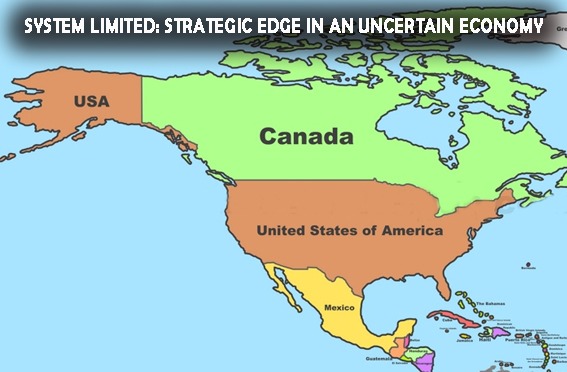System Limited: Strategic Edge in an Uncertain Economy

Abu Ahmed | May 01, 2025 at 03:42 PM GMT+05:00
May 01, 2025 (MLN): Systems Limited’s share price plummeted sharply following the announcement of imposing stringent tariffs by USA. The stock shed Rs.148 within a few trading sessions, driven by concerns that the move could significantly impact company's profitability.
Investors’ concern was not baseless. It was rested on and fueled by comments of worlds’ leading economists and business leaders, who cautioned that such protectionist measures could potentially trigger a global recession.
And they shouldn't be. A recession brings with it a wave of uncertainty that shifts client priorities and heightens price sensitivity. As a result, companies across industries experience declines in revenue and profitability. This pressure forces them to reduce costs by scaling back or deferring spending on cosmetic or non-essential services. Businesses dealing in luxury or easily substitutable goods are often among the hardest hit—and IT companies are no exception.
This write-up aims to assess the severity and immediacy of threat to Systems Limited’s profitability amid the global recession. Besides, evaluating the pursuits of System Limited to mitigate such risks.
Global Recession: A Threat to Revenue is Region Specific for System:
With 87% of consolidated revenue from exporting of IT services, System Limited by all angles appears vulnerable to global economic fluctuations.
The threat appears to be region-specific for Systems Limited, being North America and the Middle East its two primary revenue drivers- collectively accounted for 80% of the company’s consolidated revenue as per annual report 2024. When revenues from North America, Middle East and South Africa are clubbed together the figure jumped to 92%. This highlights Systems Limited’s vulnerability to economic disruptions in these key markets.
Response To Region Specific Revenue Risk:
The risk of revenue concentration in two key geographic regions—North America and the Middle East— is a risk that Systems Limited has consciously assumed as part of its business strategy. North America, being a mature IT market where the company has already established a strong footprint, offers stability and scale. Whereas, the Middle East, a rapidly growing market, offers emerging opportunities to grow.
Yet we see a notable shift in Systems Limited’s revenue composition. In 2020, North America was the largest contributor, accounting for 44% of total revenue, followed by the Middle East at 27%, Pakistan at 20%, and Europe at 8%. Over years, North America's share declined to 42% in 2021, then sharply to 23% in 2023, and to 21% in 2024. In contrast, the Middle East’s contribution has continued to rising and currently is at 55% of the consolidated revenue as per annual report of 2024.
This reflects Systems Limited’s strategic foresight in safeguarding the company during a global recession by focusing on markets that offer both stability and scalable revenue opportunities.
Price Elasticity to Demand: Another Risk to Revenue:
Global recession causes decline in demand of IT services too. Falling revenue and squeezing margin make use of digital service price sensitive, thus brings a new kind of risk to Digital Service Provides, Elasticity Risk. Studies suggest that differences in cultural norms, income levels, product complexity, and market maturity, all make products/services sensitive to price changes.
a- Price Elasticity of Demand: With Respect to Regions:
The table below provides a snapshot of the region-wise price elasticity of Systems Limited’s products and services, with contribution to consolidated revenue and factors define price elasticity of demand.
| Region | Revenue Contribution | Price Sensitivity | Reasoning |
|---|---|---|---|
| Middle East | ~55% | Low / Inelastic | Growing demand of IT Products/Services from Govt. & Private Enterprise. Stable funding by Government in long-term IT Infrastructure and consulting fuel by National Agendas. |
| North America | ~23% | Moderate / Elastic | Clients highly cost-conscious. Steady demand for advanced and specialized IT solutions. |
| Europe | Not Disclosed | Moderate | Varies by sub-region. Demand in Western Europe more stable. Demand in Eastern Europe more price-sensitive. Regulatory compliance drives inelastic demand, especially for Cybersecurity. |
| Pakistan & South Asia | ~13% (Domestic) | Highly Elastic | Focus on cost effectiveness. |
| Africa / Others | Not Disclosed (Considered minimal) | Varies | Some price elasticity due to budget constraints. Some inelasticity for essential infrastructure projects. |
Strategic Response: Deriving Demand by focusing on Inelastic Market.
The geographic realignment of business—with an increasing focus on the Middle East, a high-growth market characterized by low price elasticity—is a strategic move to ensure revenue growth while simultaneously insulating it from uncertain economic conditions.
b-Price Elasticity: With Respect to Nature of Products/Services:
Digital services are generally considered price-inelastic due to their mission-critical nature, lack of viable substitutes, and long-term service contracts. However, not all of them are equally insensitive to price change. Contrarily, demand often grows for essential IT Services such as Cyber Security, Cloud Infrastructure, and automation tools that help businesses maintain continuity and improve operational efficiency during lean period. The table below provides a snapshot of the price elasticity of digital services w.r.t. nature of products/services.
| Services Type | Price Elasticity | Reasoning |
|---|---|---|
| Core Digital Transformation | Inelastic | Demand remains steady even with price changes, as businesses must continue using such services to remain competitive. |
| Custom Software & Consulting | Elastic | Price changes somewhat affect demand – sensitivity depends on client’s budget and substitutes’ availability. |
| Non-Critical Upgrades | Elastic | Products/Services with nice-to-have features. |
Response: Deriving Demand through Inelastic Products/Services:
Systems Limited offers a broad spectrum of IT services, ranging from core to non-core segments. Core services include Digital Transformation and Enterprise Solutions, while non-core offerings include Business Process Outsourcing (BPO) and non-core Software Developments.
While a detailed breakdown of revenue by service line is not publicly available, however, 2020 Annual Report suggests that BPO services accounted for only 16% of total revenue at the time. This shows management’s strategic attempt to shield the company from the adverse effects of a global recession by ensuring maximum revenue from inelastic products and services.
c- Price Elasticity: With Respect to Client’s Maturity to Technology Adoption:
In addition to the nature of services and regional exposure, a client’s stage in technology adoption is another key factor that determines their sensitivity to price changes. The table below shows client’s sensitivity to price at different stages of technology adoption.
| Stages of Technology Adoption | Price Sensitivity | Reasoning | Region | Contribution to Revenue |
|---|---|---|---|---|
| Infancy & Growth | Highly Elastic | Business focus – cost effectiveness | South Asia, Africa | ~13% |
| High Growth | Low / Inelastic | Strong demand for digital services Operational scalability with efficiency are the prime consideration |
Middle East | ~55% |
| Maturity | Moderate / Inelastic | Steady demand of advanced and specialized IT solutions Utmost concern for data security Strict regulatory compliance |
North America | ~23% |
Response: Deriving Demand through Inelastic Products/Services
Systems Limited’s strategic presence in high-growth and matured markets enhances its economic resilience. Revenue from these regions is expected to remain stable. Demand for IT Services is mainly driven by structural shifts toward technology integration in pursuit to achieve operational efficiency. This makes Systems Limited relatively immune from global recession.
d- Price Sensitivity: With Respect to Client Types:
A client’s response to price change is also influenced by its size, operational scale, budget flexibility, and strategic of information technology for survival and growth. The following table outlines price sensitivity across various client segments, based on their operational characteristics and spending behavior.
| Client Segment | Price Elasticity | Reasoning |
|---|---|---|
| Large Enterprise | Low/Inelastic | Long-term contracts, critical services, strong vendor Relationship. |
| Governments | Very Low/ Highly Inelastic | National level transformation initiatives |
| SME(s) | Highly Elastic | Budget constraints |
| Outsourcing of outsourcing | Moderate | Price-sensitive depending on scale of contract and scope of outsourcing |
Response: Deriving Demand from Inelastic Consumers:
While the exact details of Systems Limited’s client portfolio are not publicly disclosed, insights from annual reports and investor presentations that most of its clients are government, quasi-government and large institutions, such as Pharma, Banks and Insurance. Again a strategy to immune revenue from global recession.
The Conclusion:
Despite global economic uncertainties, Systems Limited’s ability to derive major revenue from inelastic, high-valued services from matured and fast-growing markets made it resilience against global recession to a greater extent.
While demand for non-core products and service and from SME clients will remain prone to economic fluctuation but due to their limited contribution to consolidated revenue is unlikely to impact the company’s profitability significantly —let alone pose a threat to its survival or growth.
So Why the Share Price is on decline?
There are two primary reasons contributing to the recent decline in the stock price:
- USD decline in International Market
- Stock Split
a-USD Depreciation Amid Tariff-Driven Confidence Crisis:
Following the announcement of aggressive tariffs by the U.S. government, the U.S. dollar has depreciated significantly in international markets. Further weakening of the dollar is expected in coming days due to "confidence crisis" surrounded the currency currently.
Given that over 90% of the company’s revenue is USD-denominated, investors are concerned that decline in the dollar's value could result in reporting of substantial exchange losses, thereby impacting profitability for the current financial year.
a-Stock Split: 5 for 1:
While a stock split is typically perceived as a positive corporate action—enhancing share liquidity and making the stock more accessible to retail investors—it often causes short-term volatility in stock price. The recent announcement of a 5-for-1 stock split has prompted a wave of portfolio realignments, contributing to near-term price fluctuations.
Final Word:
In a recently held company briefing, Systems Limited’s management expressed confidence that the company’s profitability will not be directly impacted by the imposition of U.S. tariffs. On the contrary, the situation appears as a potential opportunity the company.
By drawing parallel to global economic stress caused by COVID-19 when there has been surge in outsourcing of IT services by foreign clients, particularly to cost-effective markets, the management expects of a similar pattern in case world economy goes into recession as feared. And Pakistan stands as a viable recipient of outsourcing digital services by foreign clients.
And Systems Limited, with its established global footprint and delivery capabilities, is well-placed to capitalize another global recession.
Copyright Mettis Link News
Related News
| Name | Price/Vol | %Chg/NChg |
|---|---|---|
| KSE100 | 136,502.54 259.91M |
1.64% 2202.77 |
| ALLSHR | 85,079.90 838.35M |
1.26% 1061.74 |
| KSE30 | 41,552.62 97.27M |
1.81% 738.33 |
| KMI30 | 193,330.76 84.69M |
0.39% 741.60 |
| KMIALLSHR | 56,315.31 366.02M |
0.43% 243.06 |
| BKTi | 38,498.08 37.91M |
4.13% 1526.33 |
| OGTi | 28,138.38 5.66M |
-0.36% -101.89 |
| Symbol | Bid/Ask | High/Low |
|---|
| Name | Last | High/Low | Chg/%Chg |
|---|---|---|---|
| BITCOIN FUTURES | 120,155.00 | 123,615.00 118,675.00 |
1625.00 1.37% |
| BRENT CRUDE | 69.13 | 71.53 69.08 |
-1.23 -1.75% |
| RICHARDS BAY COAL MONTHLY | 97.50 | 0.00 0.00 |
0.25 0.26% |
| ROTTERDAM COAL MONTHLY | 106.50 | 106.60 106.50 |
-2.20 -2.02% |
| USD RBD PALM OLEIN | 998.50 | 998.50 998.50 |
0.00 0.00% |
| CRUDE OIL - WTI | 66.89 | 69.65 66.84 |
-1.56 -2.28% |
| SUGAR #11 WORLD | 16.31 | 16.67 16.27 |
-0.26 -1.57% |
Chart of the Day
Latest News
Top 5 things to watch in this week
Pakistan Stock Movers
| Name | Last | Chg/%Chg |
|---|
| Name | Last | Chg/%Chg |
|---|

.jpg)
.jpg)
.jpg)


.png)